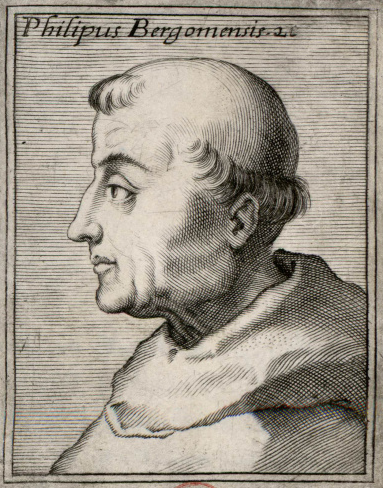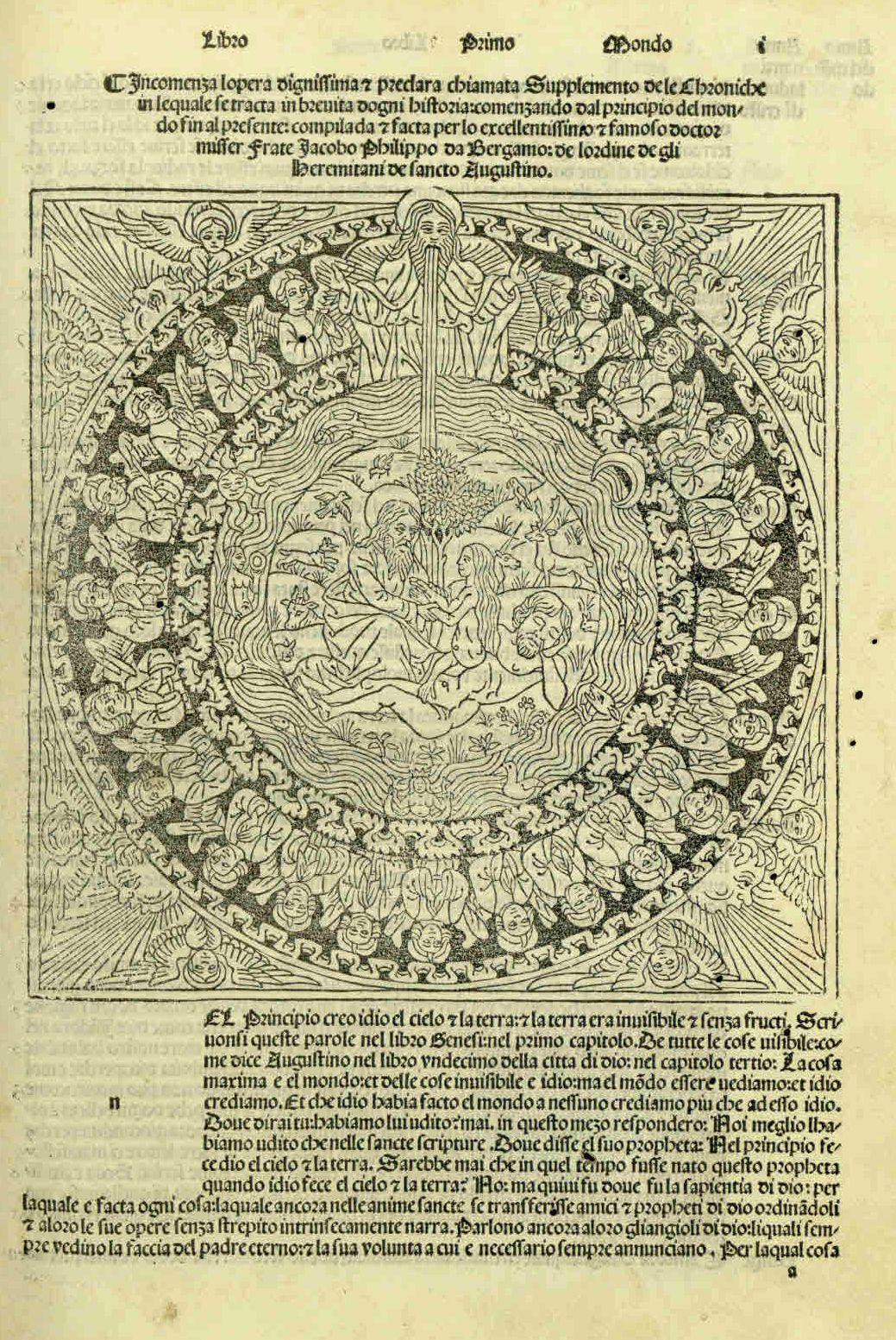Giacomo Filippo Foresti on:
[Wikipedia]
[Google]
[Amazon]

 Giacomo Filippo Foresti da Bergamo (1434–1520) was an
Giacomo Filippo Foresti da Bergamo (1434–1520) was an  His ''Supplementum chronicarum'' (first printed at Venice, 1483) was a supplement to the usual
His ''Supplementum chronicarum'' (first printed at Venice, 1483) was a supplement to the usual
; Queen of Hungary as wife to
 * ''Supplementum chronicarum'', Bernardino Benali, Venice 1483
* ''De plurimis claris selectisque mulieribus'', Lorenzo de Rubeis, Ferrara 1497
*
* ''Supplementum chronicarum'', Bernardino Benali, Venice 1483
* ''De plurimis claris selectisque mulieribus'', Lorenzo de Rubeis, Ferrara 1497
*

 Giacomo Filippo Foresti da Bergamo (1434–1520) was an
Giacomo Filippo Foresti da Bergamo (1434–1520) was an Augustinian Augustinian may refer to:
*Augustinians, members of religious orders following the Rule of St Augustine
*Augustinianism, the teachings of Augustine of Hippo and his intellectual heirs
*Someone who follows Augustine of Hippo
* Canons Regular of Sain ...
monk, known as the author of several significant early printed works. He was a chronicler
A chronicle ( la, chronica, from Greek ''chroniká'', from , ''chrónos'' – "time") is a historical account of events arranged in chronological order, as in a timeline. Typically, equal weight is given for historically important events and lo ...
and Biblical scholar.
 His ''Supplementum chronicarum'' (first printed at Venice, 1483) was a supplement to the usual
His ''Supplementum chronicarum'' (first printed at Venice, 1483) was a supplement to the usual universal chronicle
A universal history is a work aiming at the presentation of a history of all of mankind as a whole, coherent unit. A universal chronicle or world chronicle typically traces history from the beginning of written information about the past up to t ...
; it ran to numerous subsequent editions. Though it mixes mythological figures, treated euhemeristically as historical ones, on an equal footing with Christian cultural heroes, with additional chapters on the Sibyl
The sibyls (, singular ) were prophetesses or oracles in Ancient Greece.
The sibyls prophesied at holy sites.
A sibyl at Delphi has been dated to as early as the eleventh century BC by PausaniasPausanias 10.12.1 when he described local tradi ...
s and the Trojan War
In Greek mythology, the Trojan War was waged against the city of Troy by the Achaeans (Greeks) after Paris of Troy took Helen from her husband Menelaus, king of Sparta. The war is one of the most important events in Greek mythology and ...
, amongst other things, it was thought to contain Giovanni da Carignano
Giovanni da Carignano, or Johannes de Mauro de Carignano (Genoa c. 1250-Genoa 1329), was a priest and a pioneering cartographer from Genoa.
There is little certain information about his life. There is a Genoese document (dated June 9, 1291) referr ...
's lost work on papal contacts at Avignon in 1306 with Ethiopia
Ethiopia, , om, Itiyoophiyaa, so, Itoobiya, ti, ኢትዮጵያ, Ítiyop'iya, aa, Itiyoppiya officially the Federal Democratic Republic of Ethiopia, is a landlocked country in the Horn of Africa. It shares borders with Eritrea to the ...
n visitors. Recent research has both drawn attention to the Legenda Aurea
The ''Golden Legend'' (Latin: ''Legenda aurea'' or ''Legenda sanctorum'') is a collection of hagiographies by Jacobus de Voragine that was widely read in late medieval Europe. More than a thousand manuscripts of the text have survived.Hilary ...
and the letter of Prester John
Prester John ( la, Presbyter Ioannes) was a legendary Christian patriarch, presbyter, and king. Stories popular in Europe in the 12th to the 17th centuries told of a Nestorian patriarch and king who was said to rule over a Christian nation lost ...
as possible sources for Foresti's narration of the episode, casting doubt on the veracity of an Ethiopian embassy to Europe at this date, as well as a section in the ''Cronica Universalis'' of Galvano Fiamma
Galvano Fiamma (1283–1344) was an Italian Dominican and chronicler of Milan. He appears to have been the first European in the Mediterranean area to describe the New World. His numerous historical writings include the ''Chronica Galvagnana'', ...
, indicating conversely that this section of Foresti's account is entirely and directly based, to exclusion of other sources, on the cartographic treatise of Giovanni da Carignano
Giovanni da Carignano, or Johannes de Mauro de Carignano (Genoa c. 1250-Genoa 1329), was a priest and a pioneering cartographer from Genoa.
There is little certain information about his life. There is a Genoese document (dated June 9, 1291) referr ...
.
His ''De claris mulieribus'' updated the work of Boccaccio
Giovanni Boccaccio (, , ; 16 June 1313 – 21 December 1375) was an Italian writer, poet, correspondent of Petrarch, and an important Renaissance humanist. Born in the town of Certaldo, he became so well known as a writer that he was some ...
of the same title. It was dedicated to Beatrice of Aragon
Beatrice of Naples (16 November 1457 – 23 September 1508), also known as Beatrice of Aragon ( hu, Aragóniai Beatrix; it, Beatrice d'Aragona), was twice Queen of Hungary and of Bohemia by marriage to Matthias Corvinus and Vladislaus II. S ...
.; Queen of Hungary as wife to
Matthias Corvinus
Matthias Corvinus, also called Matthias I ( hu, Hunyadi Mátyás, ro, Matia/Matei Corvin, hr, Matija/Matijaš Korvin, sk, Matej Korvín, cz, Matyáš Korvín; ), was King of Hungary and Croatia from 1458 to 1490. After conducting several m ...
, see :de:Beatrix von Aragón. This book, as well as the ''Supplementum'', influenced many subsequent publications.
He also wrote a well-known confessional
A confessional is a box, cabinet, booth, or stall in which the priest in some Christian churches sits to hear the confessions of penitents. It is the usual venue for the sacrament in the Roman Catholic Church and the Lutheran Churches, but si ...
.
Works
 * ''Supplementum chronicarum'', Bernardino Benali, Venice 1483
* ''De plurimis claris selectisque mulieribus'', Lorenzo de Rubeis, Ferrara 1497
*
* ''Supplementum chronicarum'', Bernardino Benali, Venice 1483
* ''De plurimis claris selectisque mulieribus'', Lorenzo de Rubeis, Ferrara 1497
*
Notes
{{DEFAULTSORT:Foresti, Giacomo Filippo 1434 births 1520 deaths Augustinian friars Italian chroniclers 15th-century Italian historians Italian male writers